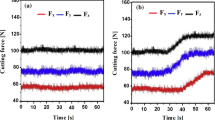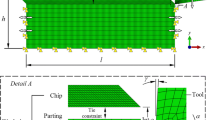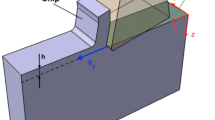Abstract
By producing of critical components in the aerospace industry is widely used the β-titanium alloy Ti10V2Fe3Al (Ti-1023) due to its extremely high ratio of strength to density, its great resistance to fatigue, its excellent resistance to corrosion and fracture toughness. This material is characterized by significant difficulties in machining. Substantial assistance in the study of the titanium alloy Ti-1023 machinability can provide a simulation of machining by numerical modeling. This paper presents the results regarding the creation of the FEM models for the cutting processes of the titanium alloy Ti-1023. The created FEM cutting models were constantly verified with experimental tests of the kinetic machining characteristics and analyses of the chip morphology by orthogonal and oblique cutting as well as flat end milling with different depths of immersion. A Johnson–Cook model was used as material model of the workpiece and the damage mechanism of the workpiece is reproduced with the Cocroft and Latham model. The parameters of material and fracture model were determined by DOE study. Comparing the experimentally established and the simulated kinetic machining characteristics and chip morphology confirms that the created FEM models are of a good quality. The size of error for simulating the chip dimensions does not exceed 10 % and ranges between 10 and 30 % for simulating the resultant forces.














Similar content being viewed by others
References
Peters M, Leyens C (2002) Titan und Titanlegierungen. Wiley-VCH Verlag GmbH & Co. KGaA, 2002, 546 S
Boyer RR, Briggs RD (2005) The use of ß-titanium alloys in the aerospace industry. J Mater Eng Perform 14(6):681–685
Biermann D, Machai C (2010) Die Alternative zu Ti-6Al-4V. Werkstatt und Betrieb 143(4):56–58
Yang H, Chen Z, Zhou Z (2015) Influence of cutting speed and tool wear on the surface integrity of the titanium alloy Ti-1023 during milling. Int J Adv Manuf Technol 78:1113–1126
Yao C, Wu D, Jin Q, Huang X, Ren J, Zhang D (2013) Influence of high-speed milling parameter on 3D surface topography and fatigue behavior of TB6 titanium alloy. Trans Nonferrous Met Soc China 23:650–660
Yang H, Chen Z, Like J (2013) Experimental study on hardness of titanium alloy Ti-1023 by milling. Adv Mater Res 690–693:2446–2449
Yao C, Wu D, Tan L, Ren J, Shi K, Yang Z (2013) Effects of cutting parameters on surface residual stress and its mechanism in high-speed milling of TB6. Proc IMechE Part B J Eng Manuf 227(4):483–493
Wagner V, Duc E (2014) Study of Ti-1023 milling with toroidal tool. Int J Adv Manuf Technol 75:1473–1491
Heisel U, Kryvoruchko DV, Zaloha VA, Storchak M, Stehle T (2009) Die FEM-Modellierung als moderner Ansatz zur Untersuchung von Zerspanprozessen. ZWF, 2009, Nr. 7–8, S. 604–616
Wu HB, Zhang SJ (2014) 3D FEM simulation of milling process for titanium alloy Ti6Al4V. Int J Adv Manuf Technol 71:1319–1326
Thepsonthi T, Özel T (2015) 3-D finite element process simulation of micro-end milling Ti-6Al-4V titanium alloy: experimental validations on chip flow and tool wear. J Mater Process Technol 221:128–145
Eberhard P, Heisel U, Storchak M, Gaugele T (2013) Dynamics and thermal interactions in metal cutting. In: Process machine interactions, 2013. Springer, Berlin, pp 309–328
Ozel T, Sima M, Srivastava A (2010) Finite element simulation of high speed machining Ti-6Al-4V alloy using modified material models. Trans NAMRI/SME 38:49–56
Deform-User Manual SFTC-Deform V11.0.2, Columbus (OH), USA, 2014
Johnson GR, Cook WH (1983) A constitutive model and data for metals subjected to large strains, high strain and high temperatures. In: Proceedings of 7th international symposium on ballistics, The Hague, Netherlands, 1983, pp 541–547
Cockroft MG, Latham DJ (1968) Ductility and workability of metals. J Inst Metals 96:33–39
Boyer RR (1980) Design properties of a high-strength titanium alloy Ti-10V-2Fe-3Al. J Metals 32(3):61–65
Robertson DG, McShane HB (1998) Analysis of high temperature flow stress of titanium alloys IMI 550 and Ti-10V-2Fe-3Al during isothermal forging. Mater Sci Technol 14:339–345
Bao R, Huang X, Cao C (2006) Deformation behavior and mechanisms of Ti-1023 alloy. Trans Nonferrous Metals Soc China 16:274–280
Calamaz M, Coupard D, Girot F (2008) A new material model for 2D numerical simulation of serrated chip formation when machining titanium alloy Ti-6Al-4V. Int J Mach Tools Manuf 48:275–288
Sima M, Özel T (2010) Modified material constitutive models for serrated chip formation simulations and experimental validation in machining of titanium alloy Ti-6Al-4V. Int J Mach Tools Manuf 50(11):943–960
Klocke F, Lung D, Buchkremer S (2013) Inverse identification of the constitutive equation of inconel 718 and AISI 1045 from FE machining simulation. Proced CIRP 8:212–217
Shrot A, Bäker M (2012) Determination of Johnson-Cook parameters from machining simulations. Comput Mater Sci 52:298–304
Zhang XP, Shivpuri R, Srivastava AK (2014) Role of phase transformation in chip segmentation during high speed machining of dual phase titanium alloys. J Mater Process Technol 214(12):3048–3066
Acknowledgments
The presented results were gained in the Project 2013DFB70110, which was funded by the International Science and Technology Cooperation Program of China. The authors would like to thank the government of the Republic of China for this support, which is highly appreciated.
Author information
Authors and Affiliations
Corresponding author
Rights and permissions
About this article
Cite this article
Storchak, M., Jiang, L., Xu, Y. et al. Finite element modeling for the cutting process of the titanium alloy Ti10V2Fe3Al. Prod. Eng. Res. Devel. 10, 509–517 (2016). https://doi.org/10.1007/s11740-016-0689-0
Received:
Accepted:
Published:
Issue Date:
DOI: https://doi.org/10.1007/s11740-016-0689-0




